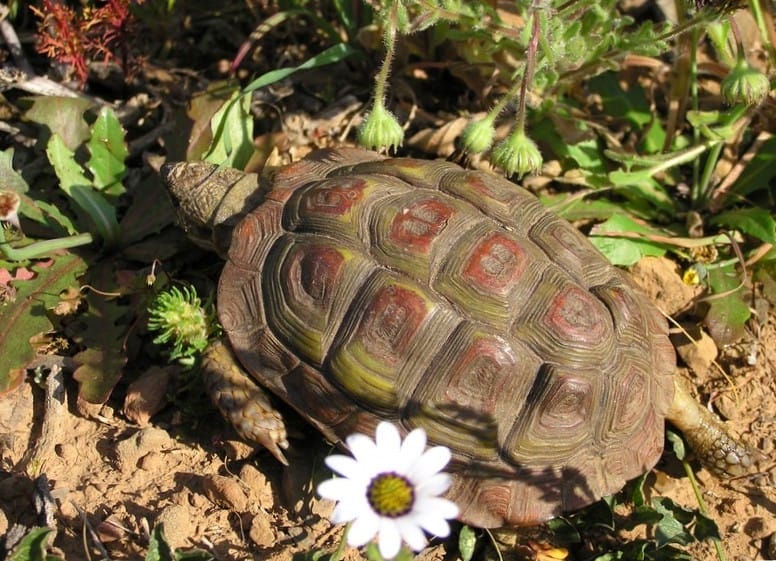Homopus areolatus (Parrot-beaked Tortoise)
Home > Turtle Database > Homopus areolatus (Parrot-beaked Tortoise)
Homopus areolatus, commonly known as the Parrot-beaked Tortoise or Common Padloper, is one of the smallest tortoise species in the world. Endemic to South Africa, this diminutive reptile is renowned for its distinctive beak-like mouth and high-domed shell, which help it thrive in its rocky, arid habitat.
Native Turtle Species Map – Find Turtles by Region
Scientific Classification
- Kingdom: Animalia
- Phylum: Chordata
- Class: Reptilia
- Order: Testudines
- Family: Testudinidae
- Genus: Homopus
- Species: Homopus areolatus
Common Names
- Parrot-beaked Tortoise
- Common Padloper
This Hilarious Turtle Book Might Know Your Pet Better Than You Do
Let’s be real—most turtle care guides feel like reading a textbook written by a sleep-deprived zookeeper.
This one’s not that.
Told from the snarky point of view of a grumpy, judgmental turtle, 21 Turtle Truths You’ll Never Read in a Care Guide is packed with sarcasm, sass, and surprisingly useful insights.
And hey—you don’t have to commit to the whole thing just yet.
Grab 2 free truths from the ebook and get a taste of what your turtle really thinks about your setup, your food choices, and that weird plastic palm tree.
It’s funny, it’s honest, and if you’ve ever owned a turtle who glares at you like you’re the problem—you’ll feel seen.
Identification
Description
Homopus areolatus is a small tortoise, measuring between 10 to 15 centimeters in carapace length. It features a high-domed shell with scutes that often display distinct growth rings. The shell coloration ranges from brown to reddish-brown, providing excellent camouflage against the rocky terrains. Its beak-like mouth is adapted for grazing on tough vegetation.
Sexual Dimorphism
Females are generally larger than males. Males possess a slightly concave plastron (the underside of the shell) and have longer tails, while females have a flat plastron and shorter tails. These differences assist in mating and are typical among tortoise species.
Check more turtles from the Homopus genus
Native Origin and Distribution
Geographical Range
This species is native to South Africa, predominantly found in the southwestern regions, including the Western Cape Province. Its range is limited, making it endemic to this specific part of the country.
Preferred Habitat
Homopus areolatus inhabits semi-arid environments characterized by rocky outcrops and sparse shrubland. It prefers areas with sandy soils, which facilitate burrowing. The rocky terrain provides shelter and protection from predators and extreme temperatures.
Behavior
Feeding Habits
The Parrot-beaked Tortoise is herbivorous, feeding on a variety of grasses, succulents, and other native vegetation. Its diet is well-suited to the arid conditions of its habitat, allowing it to extract necessary moisture from the plants it consumes.
Predators
Natural predators include birds of prey and small mammals. Human-introduced animals such as domestic dogs and cats also pose a significant threat. The tortoise’s small size and camouflage offer some protection, but predation remains a concern.
Reproduction
Breeding Season
Breeding occurs during the spring and early summer months, aligning with favorable environmental conditions. Increased temperatures and food availability support reproductive activities.
Reproductive Method
Females lay one or two hard-shelled eggs per clutch and may produce multiple clutches in a season. The eggs are buried in sandy soil, and incubation lasts several months. Hatchlings are independent upon emergence.
Conservation
Extinction Status
Homopus areolatus is currently listed as Least Concern on the IUCN Red List.
Threats
- Habitat Loss: Agricultural expansion and urban development reduce available habitat.
- Illegal Collection: The pet trade leads to over-collection from the wild.
- Predation by Introduced Species: Domestic animals increase predation pressure.
Conservation Measures
- Legal Protection: Laws regulate collection and trade.
- Habitat Conservation: Protected areas help preserve natural habitats.
- Education Programs: Raising awareness about the species’ plight aids conservation efforts.
Economic Importance
While not of significant economic importance, the Parrot-beaked Tortoise is occasionally involved in the pet trade. International regulations aim to prevent overexploitation and ensure any trade is sustainable.
Interesting Facts
- The name “Padloper” is Afrikaans for “path-walker,” highlighting the tortoise’s tendency to follow established trails.
- Homopus areolatus is among the smallest tortoise species globally, making it a subject of interest for herpetologists.
- Its cryptic coloration and elusive nature make sightings in the wild relatively rare.

About Author
Muntaseer Rahman started keeping pet turtles back in 2013. He also owns the largest Turtle & Tortoise Facebook community in Bangladesh. These days he is mostly active on Facebook.













